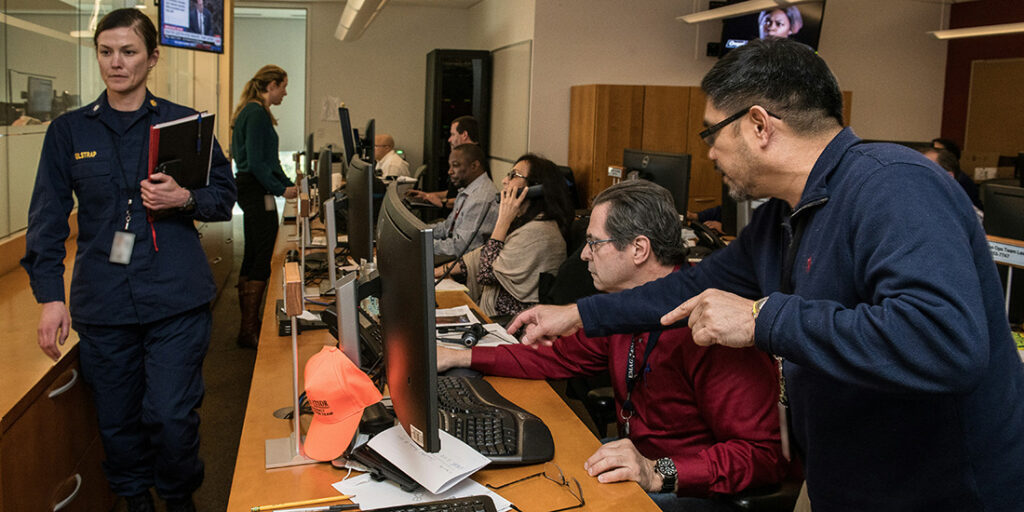Today's Top Picks
Preparing for the Next Public Health Emergency
Sustaining Those Working in Disasters
- Articles
- CBRNE
- Critical Infrastructure
- Feature
- Law Enforcement
- Public Health
- Science & Technology
- Terrorism
- Transportation
The Missing Plague Vials
Primary Care Investments to Increase Community Resilience
- Articles
- Emergency Management
- Emergency Medical Services
- Feature
- Fire
- Hazmat
- Hospitals
- Law Enforcement
- Military
- Public Health
Mental Awareness to Enhance Preparedness
Trending
 Amateurs of Action – The Women of Radio by Desiree Baccus Volunteers are transforming emergency preparedness with an inclusive, diverse movement of impactful community engagement. Explore the inspiring stories of some…
Amateurs of Action – The Women of Radio by Desiree Baccus Volunteers are transforming emergency preparedness with an inclusive, diverse movement of impactful community engagement. Explore the inspiring stories of some… Key Bridge Collapse – Transportation Infrastructure… by Joseph J. Leonard Jr. Any incident or event can easily disrupt the supply chain, whether local, regional, or international. Time will demonstrate the transportation,…
Key Bridge Collapse – Transportation Infrastructure… by Joseph J. Leonard Jr. Any incident or event can easily disrupt the supply chain, whether local, regional, or international. Time will demonstrate the transportation,… April 2024 Eclipse – Moving From Planning Into Operations by Laurel J. Radow On April 8, 2024, the path of the total solar eclipse will cross much of the middle section of the…
April 2024 Eclipse – Moving From Planning Into Operations by Laurel J. Radow On April 8, 2024, the path of the total solar eclipse will cross much of the middle section of the… A Foreign Government, Oprah, and Fires in Maui: The… by Marek N. Posard and Jessica Jensen A misinformation campaign spurred rumors that Oprah Winfrey caused the August 2023 wildfires in Maui. Foreign actors are drawn to…
A Foreign Government, Oprah, and Fires in Maui: The… by Marek N. Posard and Jessica Jensen A misinformation campaign spurred rumors that Oprah Winfrey caused the August 2023 wildfires in Maui. Foreign actors are drawn to…Domestic Preparedness Journal

Featured in this issue: Editor’s Note: Preparing for the Next Public Health Emergency by Catherine L. Feinman; The Missing Plague Vials by Robert C. Hutchinson; Primary Care Investments to Increase Community Resilience by Angie Im; Dungeons and Disasters: Gamification of Public Health Responses by Michael Etzel and Michael Prasad; Sustaining Those Working in Disasters by Jolie Wills; Mental Awareness to Enhance Preparedness by Andrew (Andy) Altizer; The “R” Word by George Schwartz; Key Bridge Collapse – Transportation Infrastructure and Global Supply Chain by Joseph J. Leonard Jr.; Week 2 – Restoring Infrastructure and Instilling Resilience by Joseph J. Leonard Jr.; and Interoperability During Mass Casualty Incidents by Charles J. Guddemi and Catherine L. Feinman.
Articles Out Loud

Article Out Loud – Sustaining Those Working in Disasters

Article Out Loud – Mental Awareness to Enhance Preparedness
Today's Top Picks
Preparing for the Next Public Health Emergency
Sustaining Those Working in Disasters
- Articles
- CBRNE
- Critical Infrastructure
- Feature
- Law Enforcement
- Public Health
- Science & Technology
- Terrorism
- Transportation
The Missing Plague Vials
Primary Care Investments to Increase Community Resilience
- Articles
- Emergency Management
- Emergency Medical Services
- Feature
- Fire
- Hazmat
- Hospitals
- Law Enforcement
- Military
- Public Health
Mental Awareness to Enhance Preparedness
Trending
 April 2024 Eclipse – Moving From Planning Into Operations by Laurel J. Radow On April 8, 2024, the path of the total solar eclipse will cross much of the middle section of the…
April 2024 Eclipse – Moving From Planning Into Operations by Laurel J. Radow On April 8, 2024, the path of the total solar eclipse will cross much of the middle section of the… A Foreign Government, Oprah, and Fires in Maui: The… by Marek N. Posard and Jessica Jensen A misinformation campaign spurred rumors that Oprah Winfrey caused the August 2023 wildfires in Maui. Foreign actors are drawn to…
A Foreign Government, Oprah, and Fires in Maui: The… by Marek N. Posard and Jessica Jensen A misinformation campaign spurred rumors that Oprah Winfrey caused the August 2023 wildfires in Maui. Foreign actors are drawn to… Amateurs of Action – The Women of Radio by Desiree Baccus Volunteers are transforming emergency preparedness with an inclusive, diverse movement of impactful community engagement. Explore the inspiring stories of some…
Amateurs of Action – The Women of Radio by Desiree Baccus Volunteers are transforming emergency preparedness with an inclusive, diverse movement of impactful community engagement. Explore the inspiring stories of some… Key Bridge Collapse – Transportation Infrastructure… by Joseph J. Leonard Jr. Any incident or event can easily disrupt the supply chain, whether local, regional, or international. Time will demonstrate the transportation,…
Key Bridge Collapse – Transportation Infrastructure… by Joseph J. Leonard Jr. Any incident or event can easily disrupt the supply chain, whether local, regional, or international. Time will demonstrate the transportation,…Domestic Preparedness Journal

Featured in this issue: Editor Note: New Year’s Resolution – Stronger Communities by Catherine L. Feinman; Resilience Versus Emergency Management by Wayne P. Bergeron; Energy Sector Perspectives by Eric Easton; Multimodal Transportation Perspectives by Nathan DiPillo and Derek Kantar; Weathering the Unknown: Inside Grant County Emergency Management by Tara Goode; Rising Above the Flood: A Decision Tool for Structural Safety by Cedric Ling, Debashish Kar, Nur Yazdani, Eyosias Beneberu, Maria Koliou, and Yong Yoo; Unleashing Community Resilience Through Collaborative Leadership by Michael R. Valiente; Commercial Facilities Sector Perspectives by Kole (KC) Campbell.
Articles Out Loud
Article Out Loud – Sustaining Those Working in Disasters
Article Out Loud – Mental Awareness to Enhance Preparedness
Today's Top Picks
Preparing for the Next Public Health Emergency
Sustaining Those Working in Disasters
- Articles
- CBRNE
- Critical Infrastructure
- Feature
- Law Enforcement
- Public Health
- Science & Technology
- Terrorism
- Transportation
The Missing Plague Vials
Primary Care Investments to Increase Community Resilience
- Articles
- Emergency Management
- Emergency Medical Services
- Feature
- Fire
- Hazmat
- Hospitals
- Law Enforcement
- Military
- Public Health
Mental Awareness to Enhance Preparedness
- Articles
- Communication & Interoperability
- Critical Infrastructure
- Cybersecurity
- Emergency Management
- Feature
- Public Health
The “R” Word
- Articles
- Communication & Interoperability
- Critical Infrastructure
- Cybersecurity
- Emergency Management
- Feature
- Fire
- Hospitals
- Public Health
- Science & Technology
Dungeons and Disasters: Gamification of Public Health Responses
- Articles
- Communication & Interoperability
- Critical Infrastructure
- Cybersecurity
- Emergency Management
- Emergency Medical Services
- Feature
- Fire
- Hospitals
- Law Enforcement
- Science & Technology
- Terrorism
Interoperability During Mass Casualty Incidents
Week 2 – Restoring Infrastructure and Instilling Resilience
An Editor’s Personal Journey to Emergency Preparedness
Trending
Domestic Preparedness Journal

Featured in this issue: Editor Note: New Year’s Resolution – Stronger Communities by Catherine L. Feinman; Resilience Versus Emergency Management by Wayne P. Bergeron; Energy Sector Perspectives by Eric Easton; Multimodal Transportation Perspectives by Nathan DiPillo and Derek Kantar; Weathering the Unknown: Inside Grant County Emergency Management by Tara Goode; Rising Above the Flood: A Decision Tool for Structural Safety by Cedric Ling, Debashish Kar, Nur Yazdani, Eyosias Beneberu, Maria Koliou, and Yong Yoo; Unleashing Community Resilience Through Collaborative Leadership by Michael R. Valiente; Commercial Facilities Sector Perspectives by Kole (KC) Campbell.
Articles Out Loud

Article Out Loud – Sustaining Those Working in Disasters























